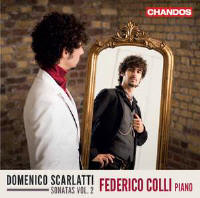Texte paru dans: / Appeared in: |
|
|
Appréciation d'ensemble / Overall evaluation :
|
|
|
Reviewer: Michael Church W Dean Sutcliffe's erudite liner note points out that amid the many things we don't know about Domenico Scarlatti there are no letters in his hand, no autographs of his sonatas - is how he wanted his sonatas to be paired, and it was apparently his intention that they should be. The two most authoritative sources for these work pair them according to key, thus suggesting their intrinsic musical compatibilities.
Federico Colli, in his own liner note, offers a radically new rationale for pairing. Dispensing with similarity of key, he explains that his own pairings have been determined by his desire to present the sonatas in such a way, as to embody his Platonic idea of the harmony of beauty through opposition. Its clear that no editor has had the temerity to rein in Colli's pseudo-philosophical prose, but behind his windy rhetoric there actually lurks an important insight. At the heart of Scarlatti's art, with its gritty dissonances, unsettling harmonic progressions and aggressiveIy juxtaposed styles lies that concept of opposition. Colli may present his chosen 16 sonatas as eight double ones, but there's just one pairing where the sonatas are so close in style and tone - KK 63 and 64 - that they might almost be twins.
Yet at one level, all this feels beside the point. To me - and probably to most other listeners - each sonata is a microcosm, a world in itself, when I listen to one of these perfect little works, I do so in and for the moment; I don’t contrast it, either consciously or unconsciously, with what I may have just heard the moment before.
No, the real point of this
recording is its wonderful pianism; and unlike many contemporary pianists - most
notably Lucas Debargue - Colli takes no liberties with the text. We are led in
gently, KK 144 being played with demure delicacy before KK 427 is delivered with
explosive brilliance, and KK 25 with
And there are surprises, too. KK 431 - all 16 bars of it – lasts just 52 seconds; KK 95, which most scholars think is not by Scarlatti, rounds off the recording in Mozartian musical-box style, its end hanging in mid-phrase.
Colli's springy touch throughout is marvellously responsive to the passing weather in this beautifully contrived landscape: if he does a Ralph Kirkpatrick and records all 555 sonatas, I will be in the queue to get them.
| |
|
|
|
|
|
|
|
Cliquez l'un ou l'autre
bouton pour découvrir bien d'autres critiques de CD |
|




